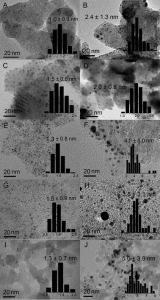
TEM images and size distribution (inset) of various Au25 (1 wt%)/support samples before and after 300 °C calcination.
The use of nanogold (Au NP) catalysts has been widely established for various applications including pharmaceuticals and perfumes. However, their usage has been limited due to the conventional protocols employed for Au NP synthesis producing polydisperse size ranges, which have proven problematic for identifying catalytic active sites. Recently, this issue has been circumvented through instead using Au nanoclusters (Au NCs), which produce defined cluster sizes with well-defined physiochemical properties. As a direct consequence of being able to exert such control, there have been a number of applications established using such catalysts for processes including CO oxidation, and the oxidation of styrene and cyclohexane. However, whilst the role of the solid support is well established for Au NP catalysis, there currently exists a lack of knowledge on what effect/role the support plays in Au NCs catalysis.
In this study, Fang and co-workers report a systematic assessment of thiolated Au NCs on five different solid supports through examination of the size and electronic structure evolution of the Au NCs during heat treatment, and their catalytic performance when applied to the hydrogenation of nitrobenzene and oxidation of styrene. The solid supports investigated include hydroxy-apatite (HAP), TiO2 (P25), activated carbon (AC), pyrolyzed grapheme oxide (PGO) and fumed SiO2.
The key findings of these studies establish that AuNCs on HAP and P25 supports presented enhanced activities over the other considered supports. This was found to be due to a number of factors, including reduced NC growth during calcination (heat treatment) following the removal of the thiolated ligands from the nanocluster surface. Further to this, the catalytic activity established during the hydrogenation of nitrobenzene and oxidation of styrene overwhelmingly showed that AuNC-HAP had a greater activity than any of the other supported catalysts. This was found to be due to both the reduced NC growth following heat treatment, and a change in the electronic structure of bound Au, resulting in strengthened metal support interactions.
Although this study has shown HAP to be a superior support in comparison to the others investigated, it should be noted that during heat treatment, an increase in the size of the nanoclusters was still observed. As a consequence of this, the authors have objectively established improvements which should be made for future studies, including pursuing different support methods and improving the conditions under which the thiolated ligands can be removed from the Au NCs.
The support effect on the size and catalytic activity of thiolated Au25 nanoclusters as precatalysts
Jun Fang, Jingguo Li, Bin Zhang, Xun Yuan, Hiroyuki Asakura, Tsunehiro Tanaka, Kentaro Teramura, Jianping Xie and Ning Yan
Nanoscale, 2015, 7, 6325-6333. DOI: 10.1039/C5NR00549C
Dr Derek Craig is a guest web writer for the Nanoscale blog. He is a Post Doctoral Research Fellow at the University of St. Andrews based in the fields of Biophotonics and Materials Science. With a background in chemistry, his work mainly focuses on the synthesis of nano to meso materials and the use of imaging techniques to study biological samples.










